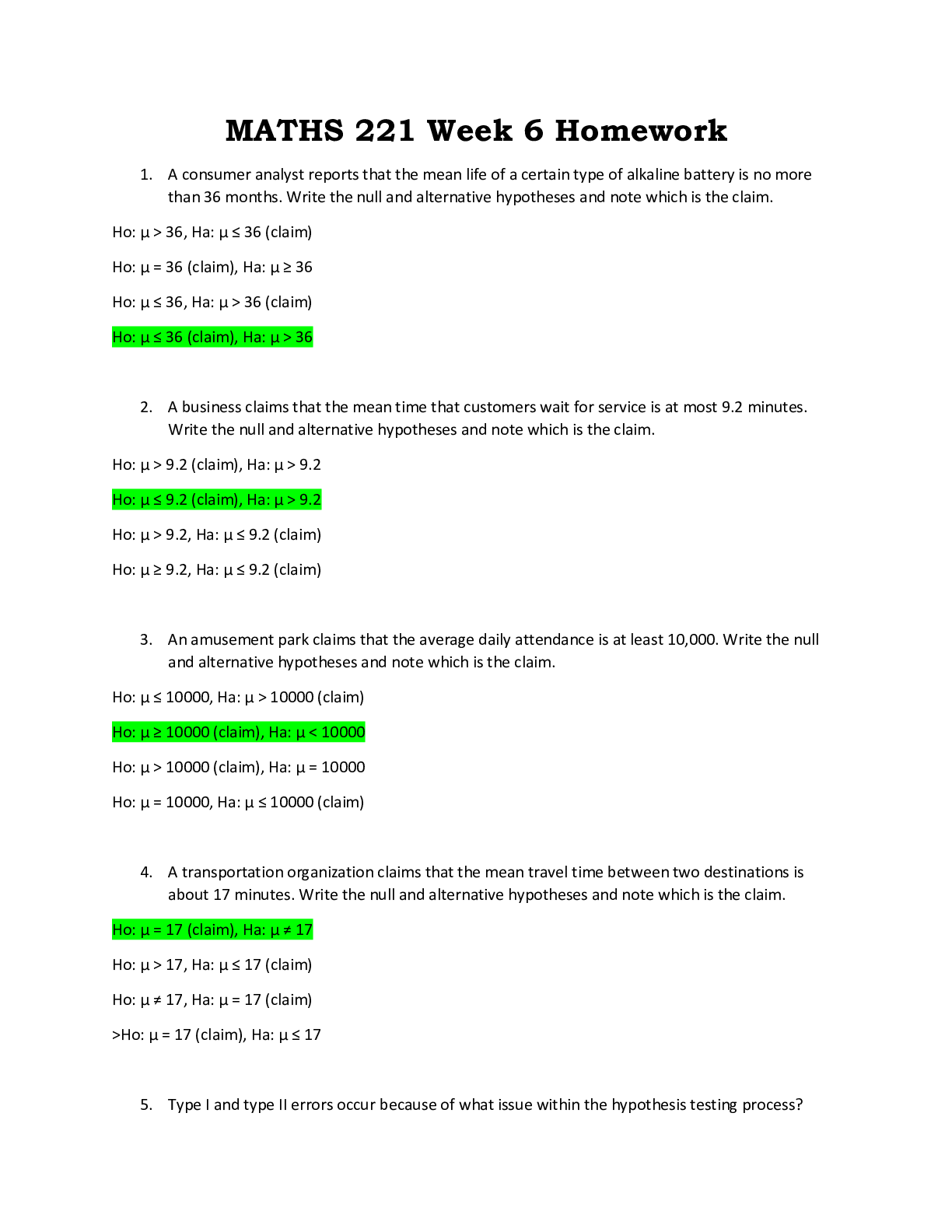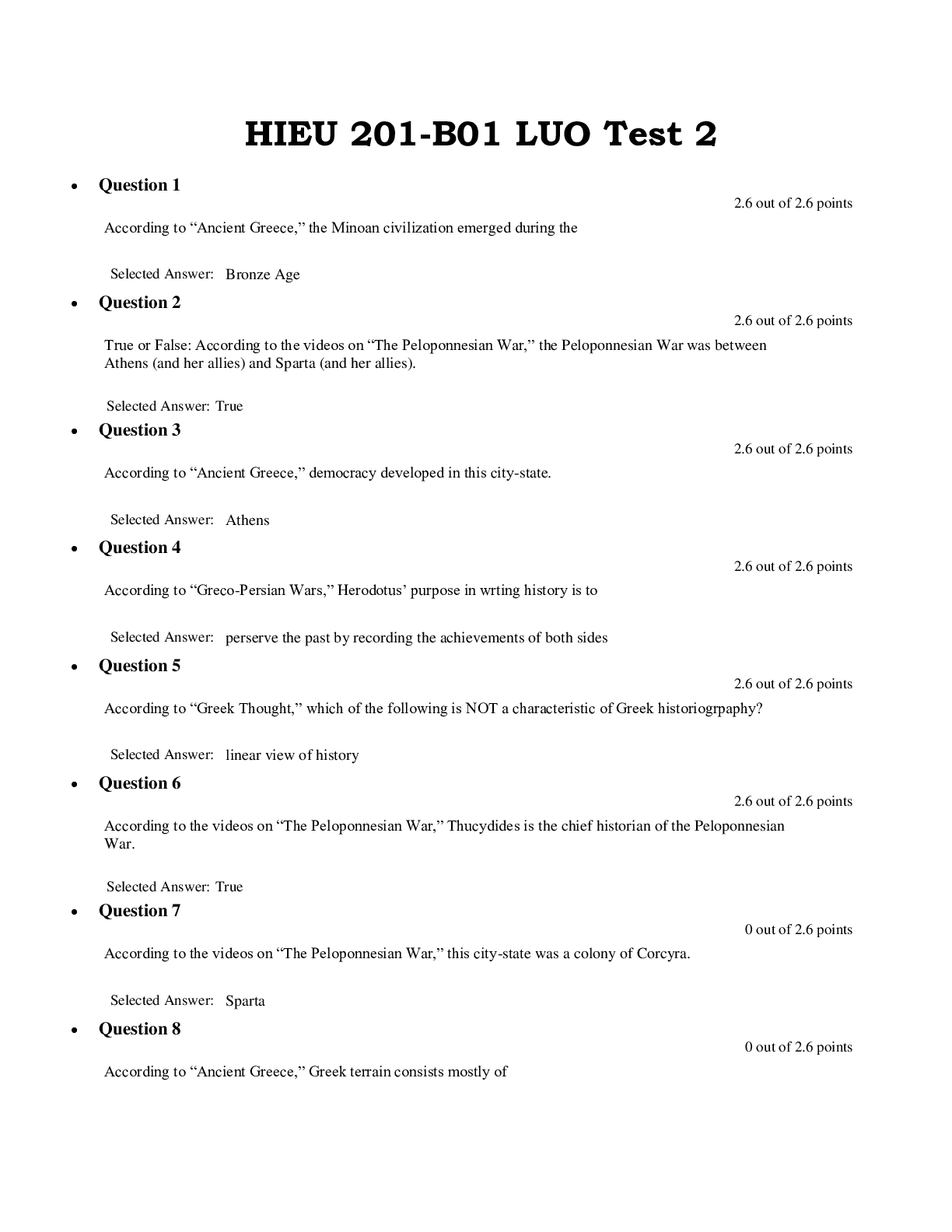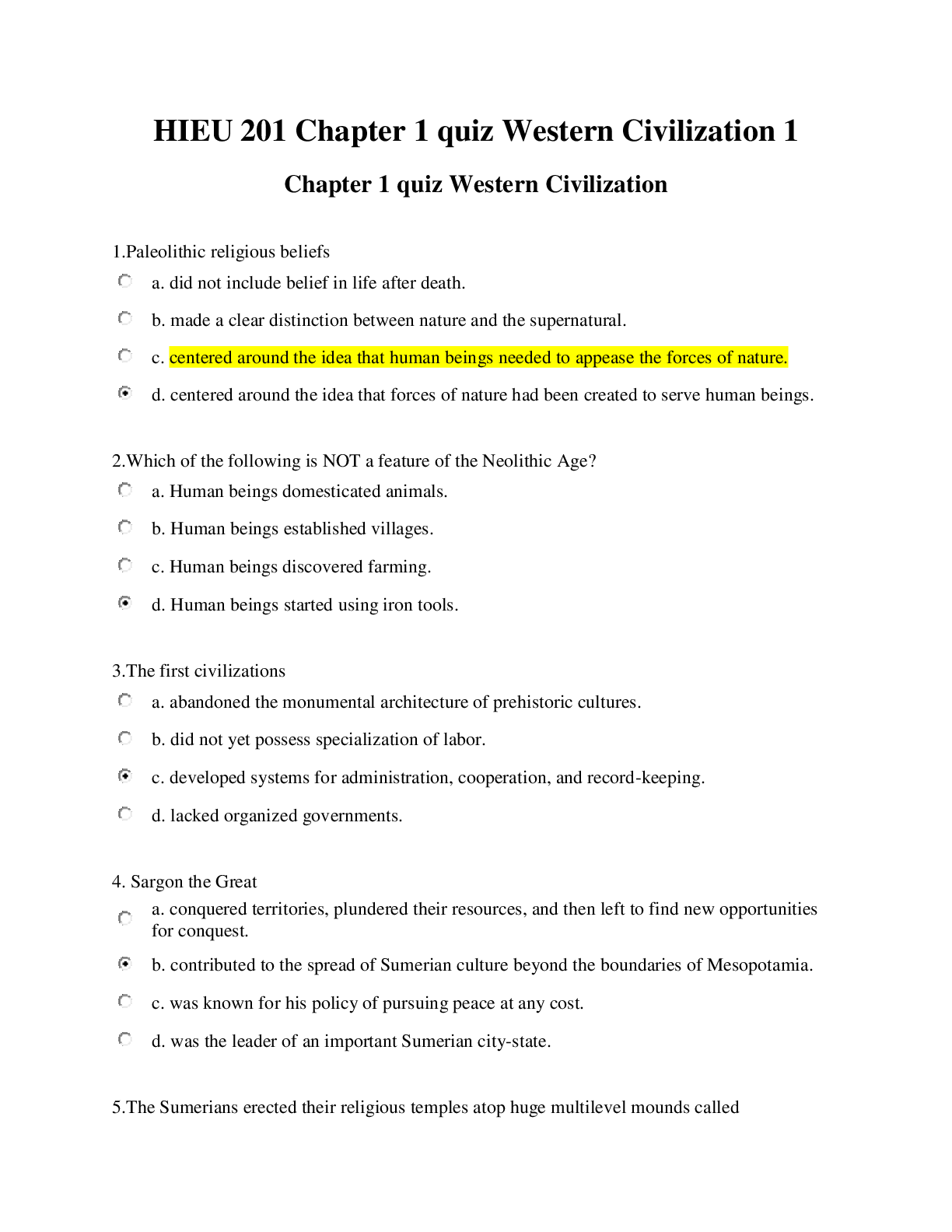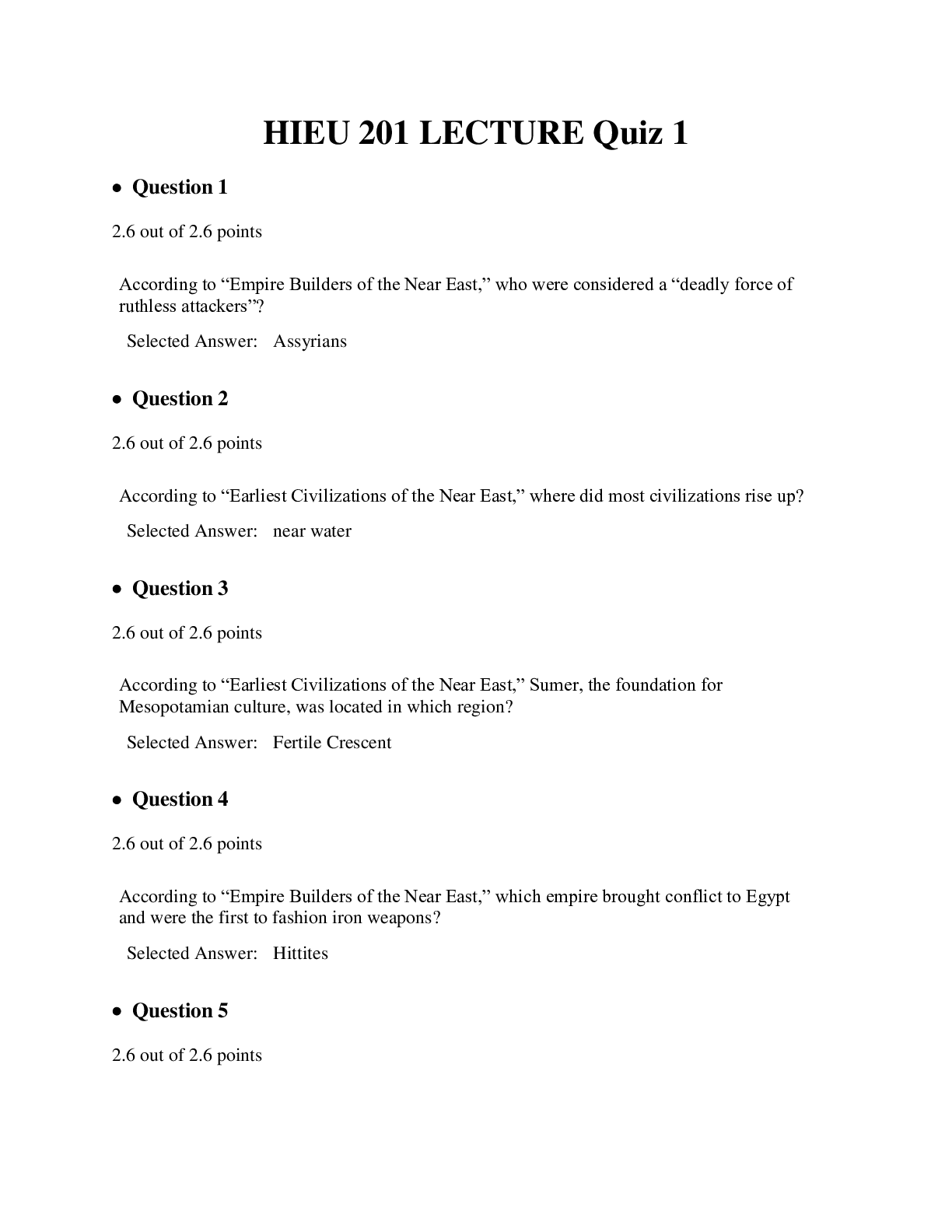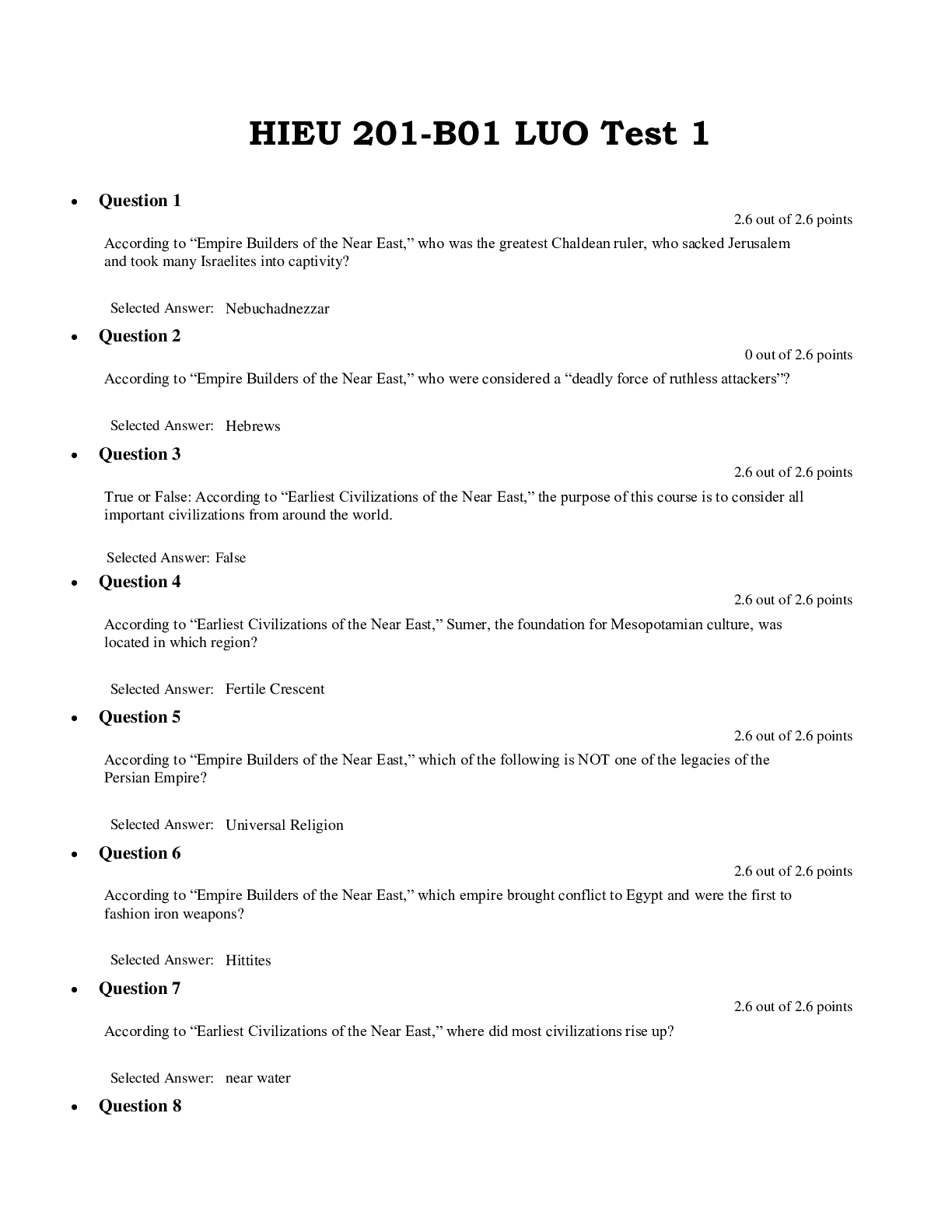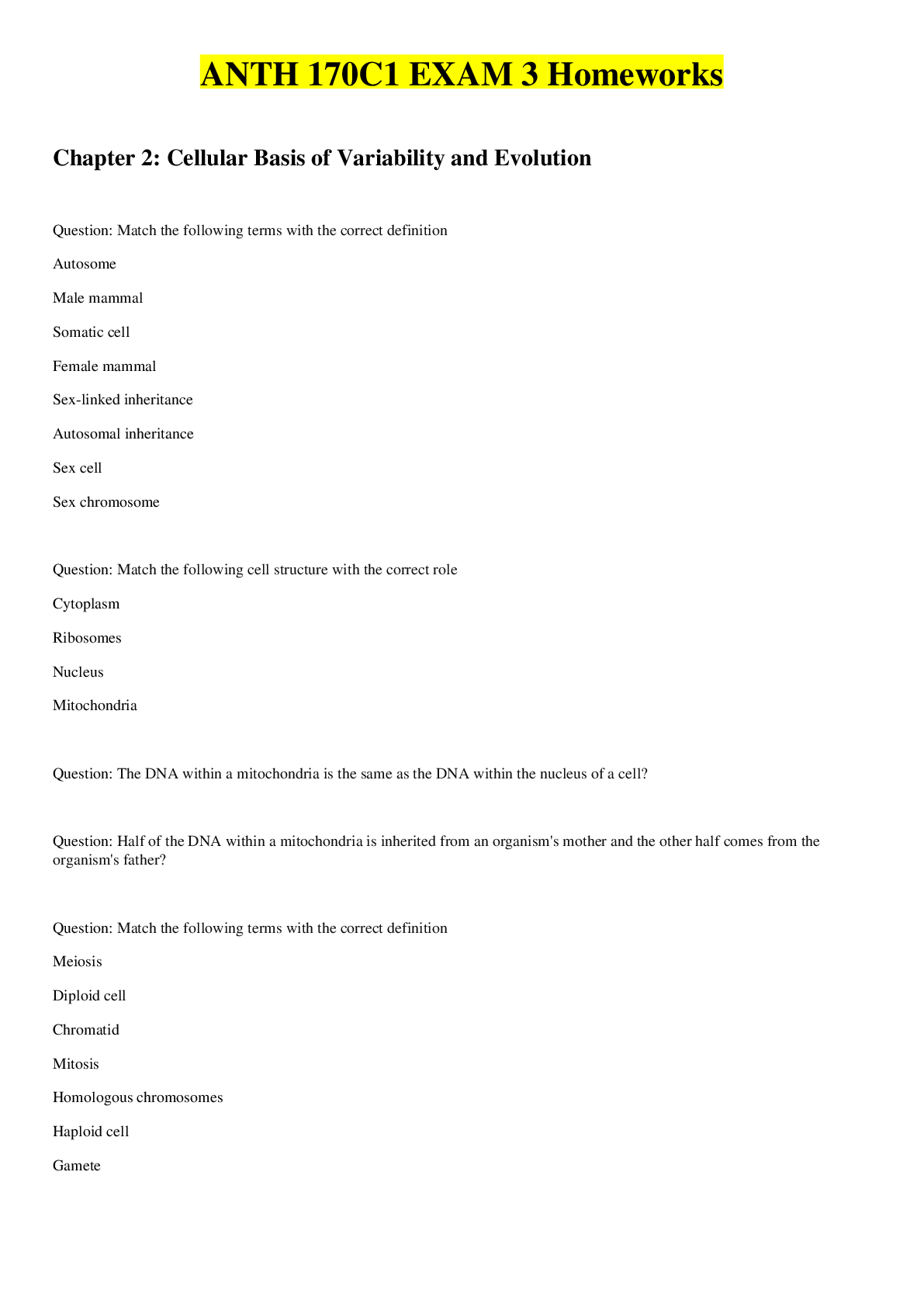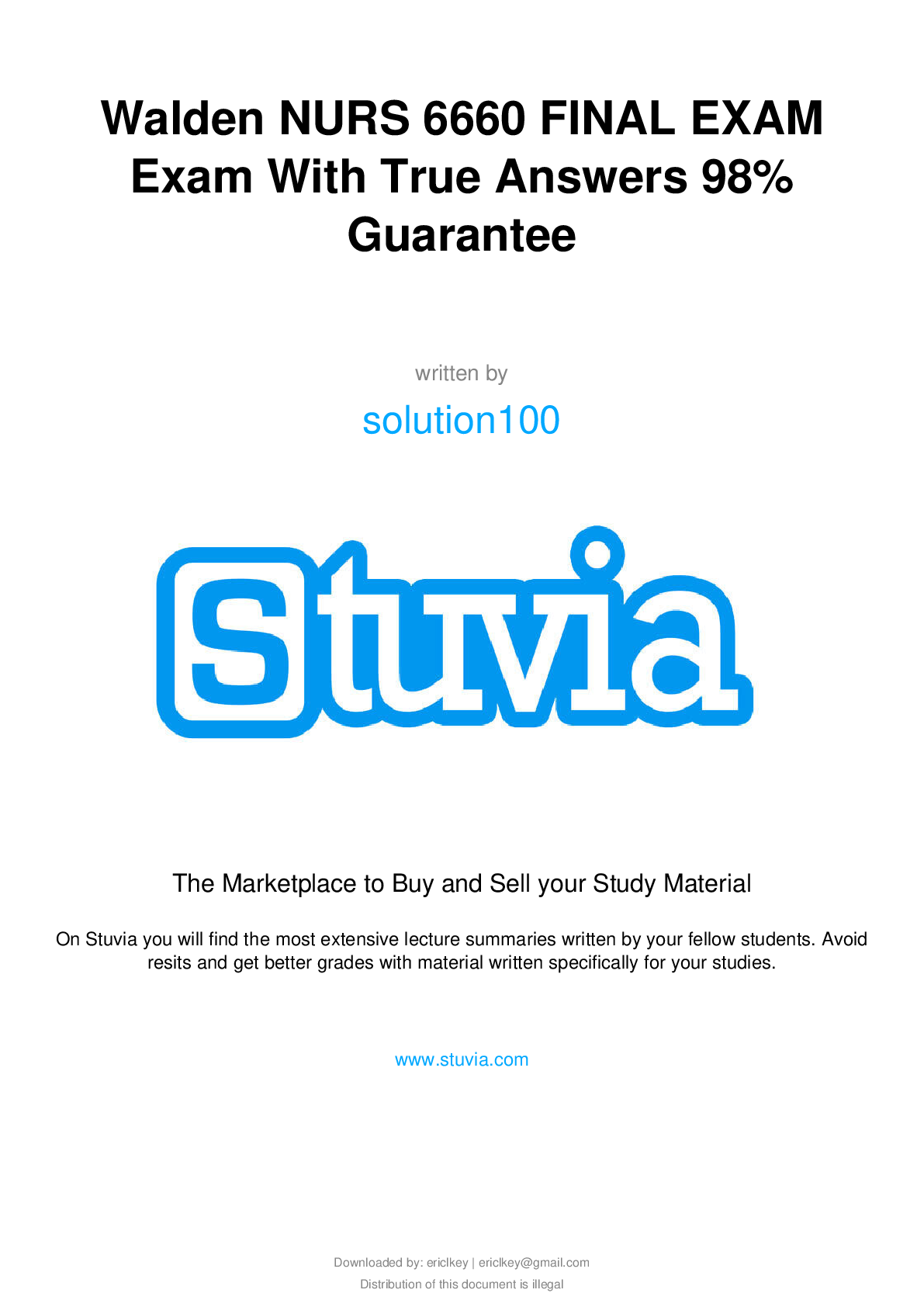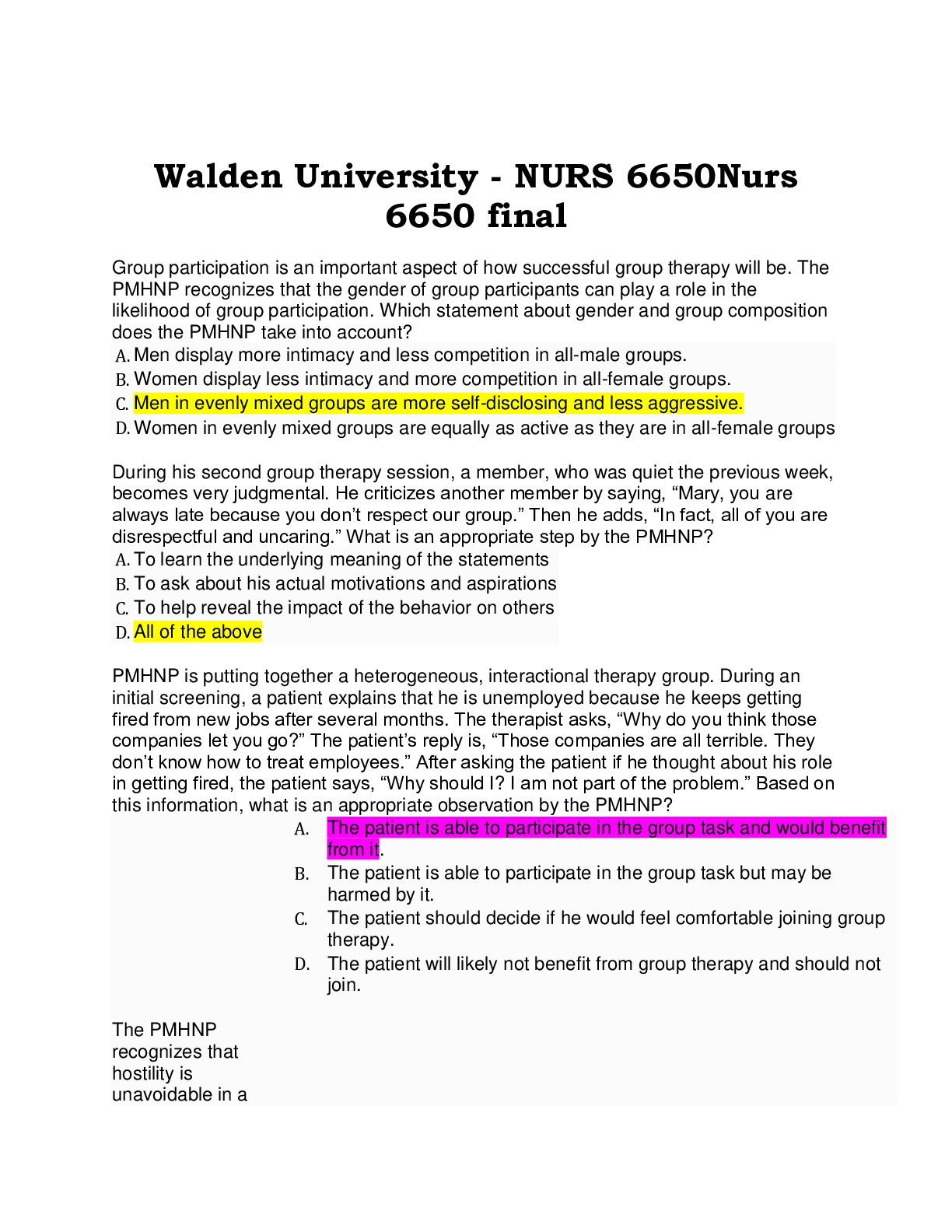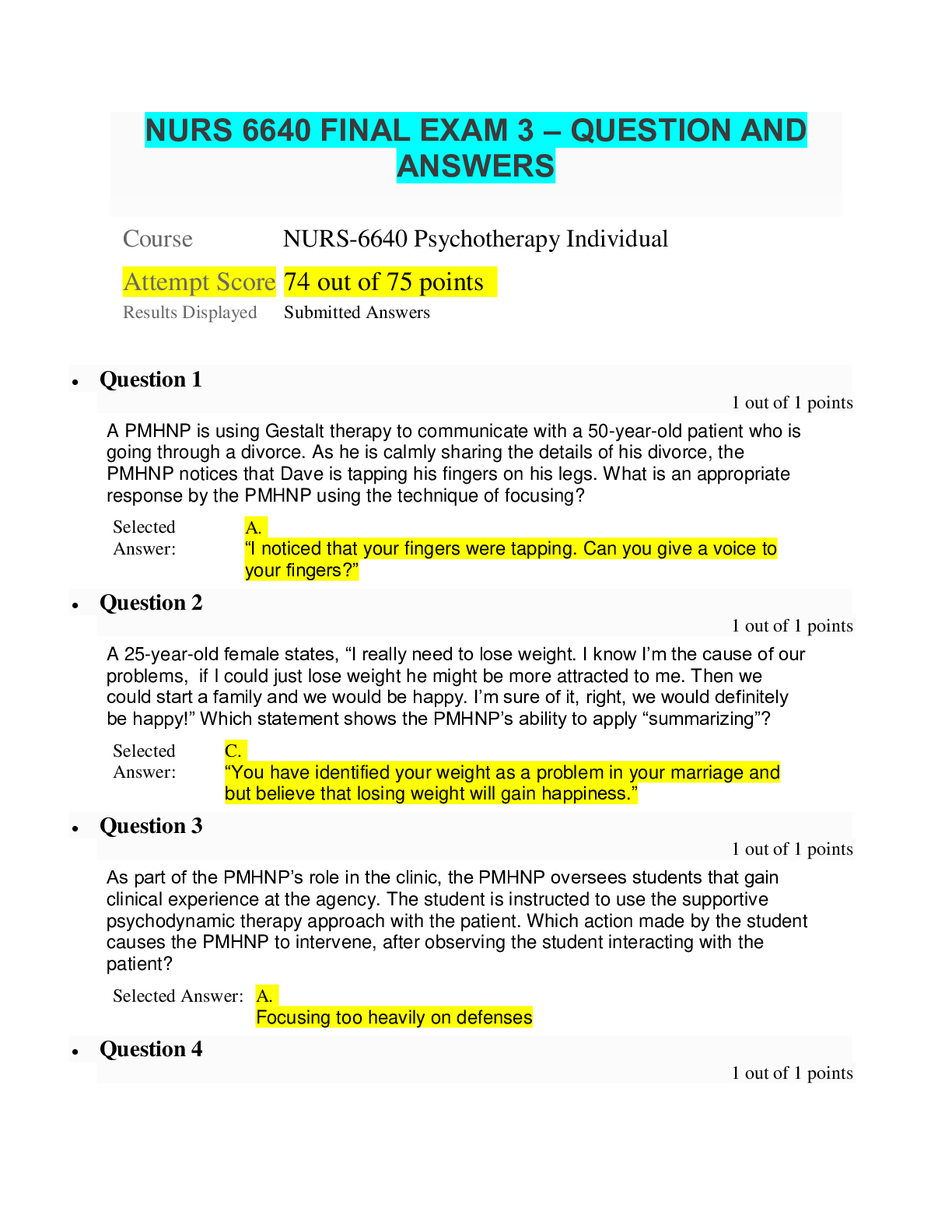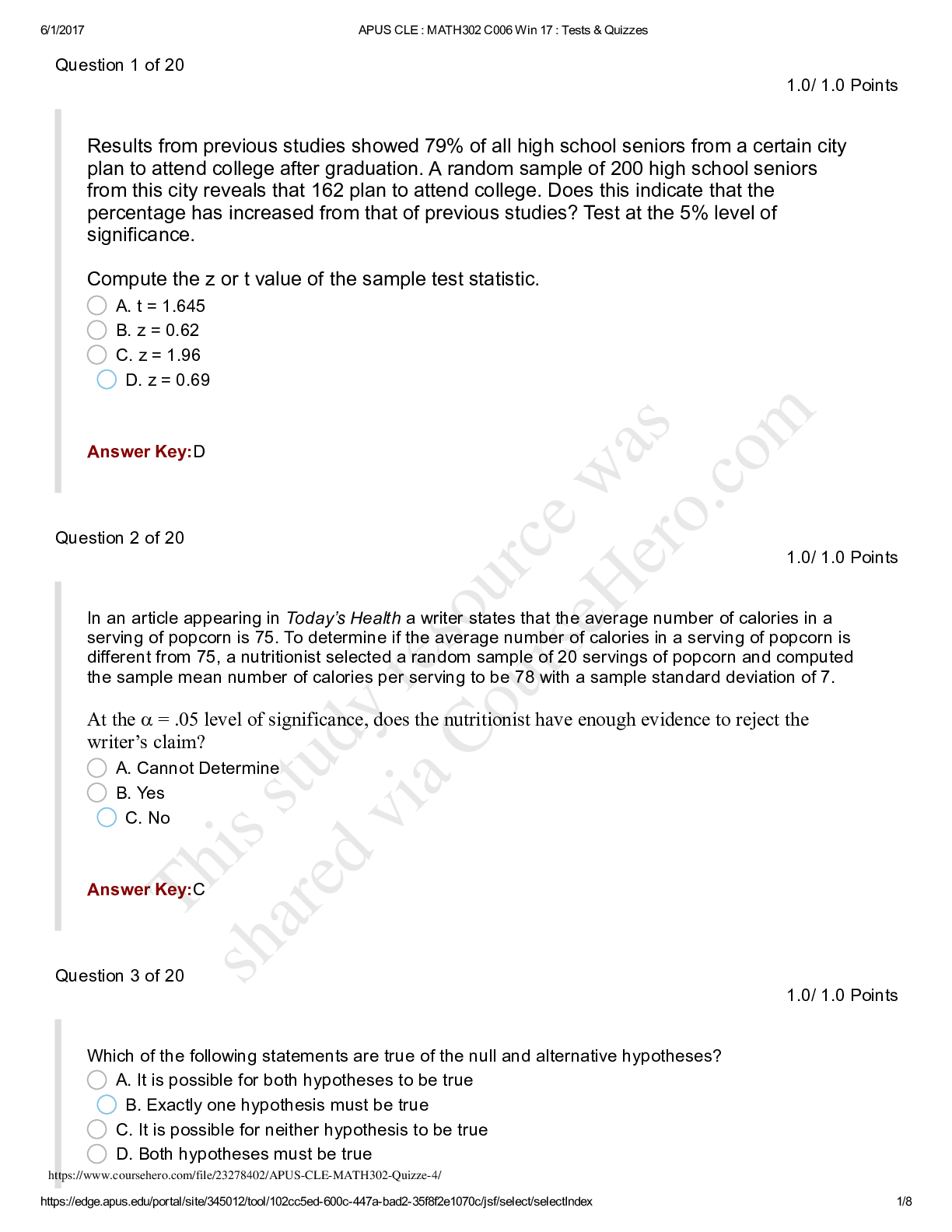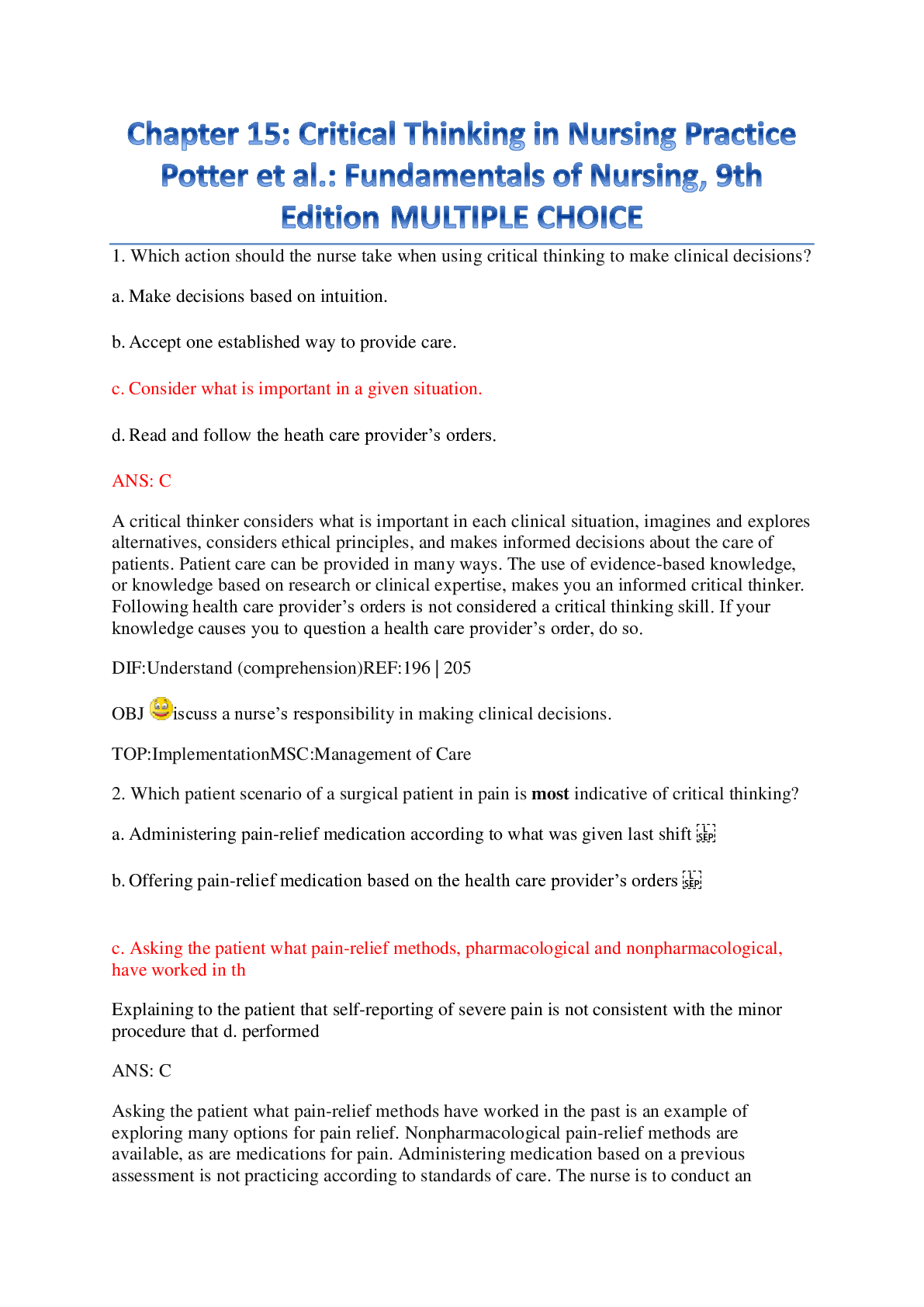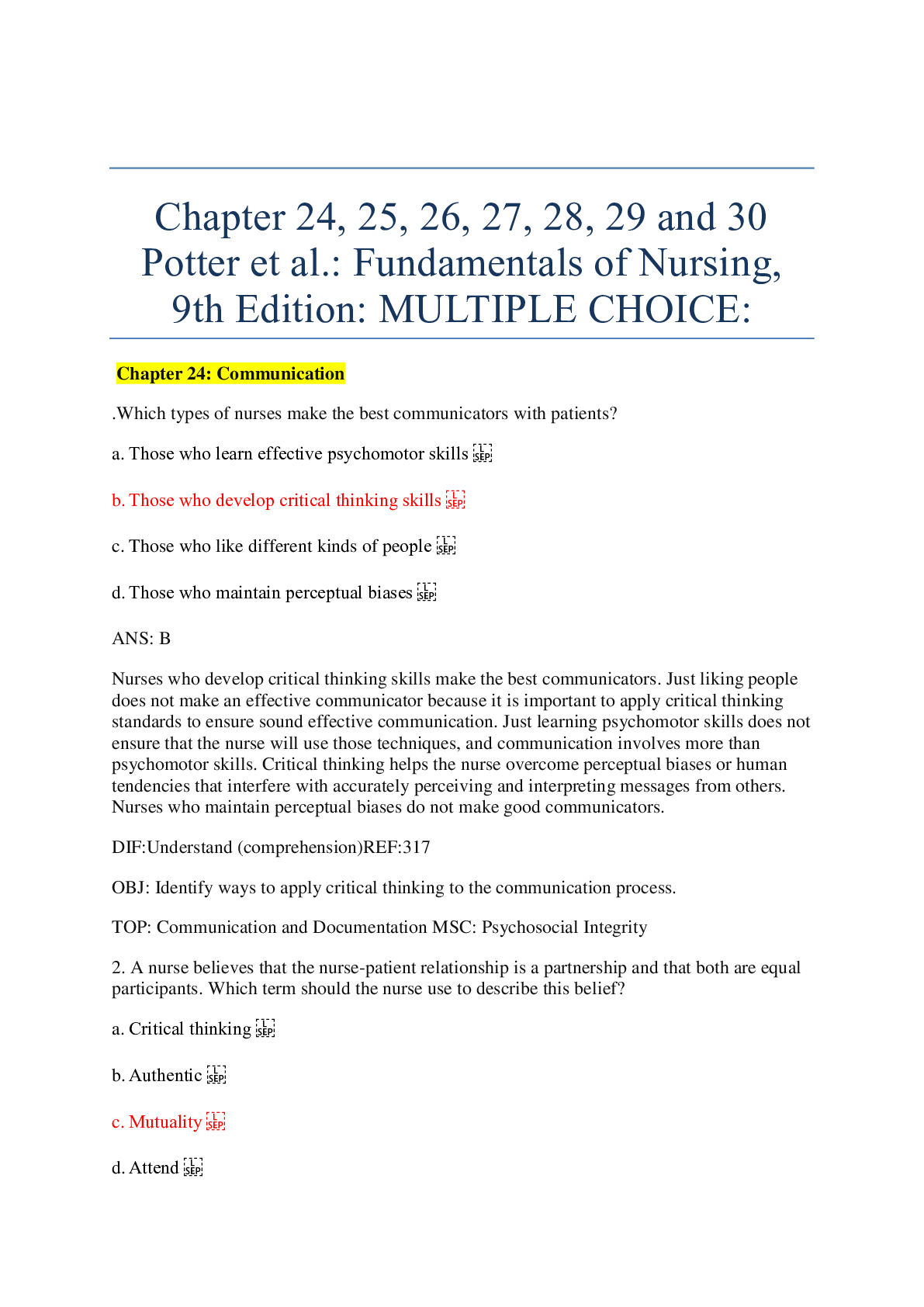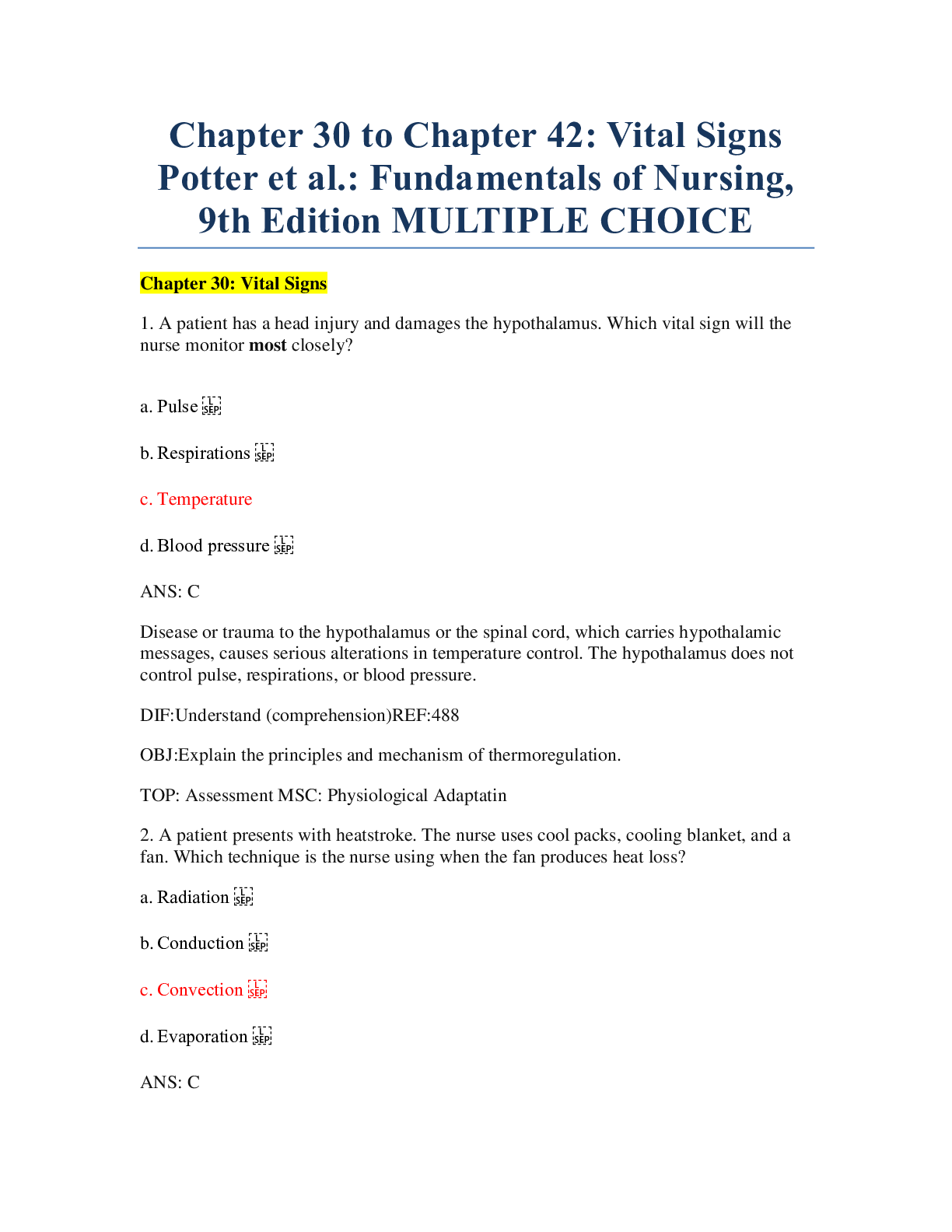*NURSING > QUESTIONS & ANSWERS > NURS 572AChapter 30 to Chapter 42 Vital Signs Potter et al.: Fundamentals of Nursing, 9th Edition MU (All)
NURS 572AChapter 30 to Chapter 42 Vital Signs Potter et al.: Fundamentals of Nursing, 9th Edition MULTIPLE CHOICE --Graded A
Document Content and Description Below
Chapter 30 to Chapter 42: Vital Signs Potter et al.: Fundamentals of Nursing, 9th Edition MULTIPLE CHOICE Chapter 30: Vital Signs 1. A patient has a head injury and damages the hypothalamus. Which... vital sign will the nurse monitor most closely? 2. A patient presents with heatstroke. The nurse uses cool packs, cooling blanket, and a fan. Which technique is the nurse using when the fan produces heat loss? a. Radiation b. Conduction c. Convection d. Evaporation 3. The patient has a temperature of 105.2° F. The nurse is attempting to lower temperature by providing tepid sponge baths and placing cool compresses in strategic body locations. Which technique is the nurse using to lower the patient’s temperature? a. Radiation b. Conduction c. Convection d. Evaporation 4. A nurse is focusing on temperature regulation of newborns and infants. Which action will the nurse take? a. Apply just a diaper. b. Double the clothing. c. Place a cap on their heads. d. Increase room temperature to 90 degrees. 5. The nurse is working the night shift on a surgical unit and is making 4:00 AM rounds. The nurse notices that the patient’s temperature is 96.8° F (36° C), whereas at 4:00 PM the preceding day, it was 98.6° F (37° C). What should the nurse do? a. Call the health care provider immediately to report a possible infection. b. Administer medication to lower the temperature further. c. Provide another blanket to conserve body temperature. d. Realize that this is a normal temperature variation. 6. The nurse is caring for a patient who has a temperature reading of 100.4° F (38° C). The patient’s last two temperature readings were 98.6° F (37° C) and 96.8° F (36° C). Which action will the nurse take? b. Wait 30 minutes and recheck the patient’s temperature. c. Assume that the patient has an infection and order blood cultures. d. Encourage the patient to move around to increase muscular activity. e. Be aware that temperatures this high are harmful and affect patient safety. 7. A patient is pyrexic. Which piece of equipment will the nurse obtain to monitor this condition? a. Stethoscope a. Thermometer b. Blood pressure cuffc. Sphygmomanometer 8. The nurse is caring for a patient who has an elevated temperature. Which principle will the nurse consider when planning care for this patient? a. Hyperthermia and fever are the same thing. b. Hyperthermia is an upward shift in the set point. c. Hyperthermia occurs when the body cannot reduce heat production. d. Hyperthermia results from a reduction in thermoregulatory mechanisms. 9. The patient with heart failure is restless with a temperature of 102.2° F (39° C). Which action will the nurse take? a. Place the patient on oxygen. b. Encourage the patient to cough. c. Restrict the patient’s fluid intake. d. Increase the patient’s metabolic rate. 10. The patient requires temperatures to be taken every 2 hours. Which task will the nurse assign to an RN? a. Using appropriate route and device b. Assessing changes in body temperature c. Being aware of the usual values for the patient d. Obtaining temperature measurement at ordered frequency 11. The patient requires routine temperature assessment but is confused, easily agitated, and has a history of seizures. Which route will the nurse use to obtain the patient’s temperature? a. Oral b. Rectal c. Axillary d. Tympanic 12. The patient is being admitted to the emergency department following a motor vehicle accident. The patient’s jaw is broken with several broken teeth. The patient is ashen, has cool skin, and is diaphoretic. Which route will the nurse use to obtain an accurate temperature reading? a. Oral b. Axillary c. Tympanic d. Temporal 13. The nurse is caring for an infant and is obtaining the patient’s vital signs. Which artery will the nurse use to bestobtain the infant’s pulse? a. Radial b. Brachial c. Femoral d. Popliteal 14. The patient is found to be unresponsive and not breathing. Which pulse site will the nurse use? a. Radial b. Apical c. Carotid d. Brachial 15. The nurse needs to obtain a radial pulse from a patient. What must the nurse do to obtain a correct measurement? b. Place the tips of the first two fingers over the groove along the thumb side of the patient’s wrist. c. Place the tips of the first two fingers over the groove along the little finger side of the patient’s wrist. d. Place the thumb over the groove along the little finger side of the patient’s wrist. e. Place the thumb over the groove along the thumb side of the patient’s wrist. 16. The nurse is assessing the patient’s respirations. Which action by the nurse is most appropriate? a. Inform the patient that she is counting respirations. b. Do not touch the patient until completed. c. Obtain without the patient knowing. d. Estimate respirations. 17. The patient’s blood pressure is 140/60. Which value will the nurse record for the pulse pressure? a. 60 b. 80 c. 140 d. 200 18. The nurse reviews the laboratory results for a patient and determines the viscosity of the blood is thick. Which laboratory result did the nurse check? a. Arteral blood gas a. Blood culture b. Hematocrit c. Potassium 19. The patient is being admitted to the emergency department with reports of shortness of breath. The patient has had chronic lung disease for many years but still smokes. Whatwill the nurse do? a. Allow the patient to breathe into a paper bag. b. Use oxygen cautiously in this patient. c. Administer high levels of oxygen. 20. A nurse is reviewing capnography results for adult patients. Which value will cause the nurse to follow up? a. 35 mm Hg b. 40 mm Hg c. 45 mm Hg d. 50 mm Hg 21. The nurse is caring for a patient who has a pulse rate of 48. His blood pressure is within normal limits. Which finding will help the nurse determine the cause of the patient’s low heart rate? b. The patient has a fever. c. The patient has possible hemorrhage or bleeding. d. The patient has chronic obstructive pulmonary disease (COPD). e. The patient has calcium channel blockers or digitalis medication prescriptions. 22. The patient was found unresponsive in an apartment and is being brought to the emergency department. The patient has arm, hand, and leg edema, temperature is 95.6° F, and hands are cold secondary to a history of peripheral vascular disease. It is reported that the patient has a latex allergy. What should the nurse do to quickly measure the patient’s oxygen saturation? a. Attach a finger probe to the patient’s index finger. b. Place a nonadhesive sensor on the patient’s earlobe. c. Attach a disposable adhesive sensor to the bridge of the patient’s nose. d. Place the sensor on the same arm that the electronic blood pressure cuff is on. 23. The patient is admitted with shortness of breath and chest discomfort. Which laboratory value could account for the patient’s symptoms? a. Red blood cell count of 5.0 million/mm3 a. Hemoglobin level of 8.0 g/100 mL b. Hematocrit level of 45% c. Pulse oximetry of 95% 24. A nurse reviews blood pressures of several patients. Which finding will the nurse report as prehypertension? a. 98/50 in a 7-year-old child b. 115/70 in an infant c. 120/80 in a middle-aged adult d. 146/90 in an older adult 25. The nurse is providing a blood pressure clinic for the community. Which group will the nurse most likely address? a. Non-Hispanic Caucasians b. European Americans c. African-Americans d. Asian Americans 26. A nurse is caring for a patient who smokes and drinks caffeine. Which point is important for the nurse to understand before assessing the patient’s blood pressure (BP)? a. Smoking increases BP for up to 3 hours. b. Caffeine increases BP for up to 15 minutes. c. Smoking result in vasoconstriction, falsely elevating BP. d. Caffeine intake should not have occurred 30 to 40 minutes before BP measurement. 27. When taking the pulse of an infant, the nurse notices that the rate is 145 beats/min and the rhythm is regular. How should the nurse interpret this finding? a. This is normal for an infant. b. This is too fast for an infant. c. This is too slow for an infant. d. This is not a rate for an infant but for a toddler. 28. The nurse is caring for an older-adult patient and notes that the temperature is 96.8° F (36° C). How will the nurse interpret this finding? a. The patient has hyperthermia. b. The patient has a normal temperature. c. The patient is suffering from hypothermia. d. The patient is demonstrating increased metabolism. 29. When assessing the temperature of newborns and children, the nurse decides to utilize a temporal artery thermometer. What is the rationale for the nurse’s action? a. It is not affected by skin moisture. a. It has no risk of injury to patient or nurse. b. It reflects rapid changes in radiant temperature. c. It is accurate even when the forehead is covered with hair. 30. The nurse is caring for a small child and needs to obtain vital signs. Which site choice from the nursing assistive personnel (NAP) will cause the nurse to praise the NAP?b. Ulnar site c. Radial site d. Brachial site e. Femoral site 31. The nurse is caring for a newborn infant in the hospital nursery and notices that the infant is breathing rapidly but is pink, warm, and dry. Which normal respiratory rate will the nurse consider when planning care for this newborn? a. 30 to 60 b. 22 to 28 c. 16 to 20 d. 10 to 15 32. The nurse is preparing to obtain an oxygen saturation reading on a toddler. Which action will the nurse take? a. Secure the sensor to the toddler’s earlobe. b. Determine whether the toddler has a latex allergy. c. Place the sensor on the bridge of the toddler’s nose. d. Overlook variations between an oximeter pulse rate and the toddler’s pulse rate. 33. The nurse is preparing to assess the blood pressure of a 3-year-old. How should the nurse proceed? a. Use the diaphragm portion of the stethoscope to detect Korotkoff sounds. b. Obtain the reading before the child has a chance to “settle down.” c. Choose the cuff that says “Child” instead of “Infant.” d. Explain the procedure to the child. 34. A nurse is caring for a group of patients. Which patient will the nurse see first?a. A crying infant with P-165 and R-54 b. A sleeping toddler with P-88 and R-23 c. A calm adolescent with P-95 and R-26 d. An exercising adult with P-108 and R-24 35. The nurse is caring for a patient who is being discharged from the hospital after being treated for hypertension. The patient is instructed to take blood pressure 3 times a day and to keep a record of the readings. The nurse recommends that the patient purchase a portable electronic blood pressure device. Which other information will the nurse share with the patient? a. You can apply the cuff in any manner. b. You will need to recalibrate the machine. c. You can move your arm during the reading. d. You will need to use a stethoscope properly. 36. The nurse is caring for a patient who reports feeling light-headed and “woozy.” The nurse checks the patient’s pulse and finds that it is irregular. The patient’s blood pressure is 100/72. It was 113/80 an hour earlier. What should the nurse do? a. Apply more pressure to the radial artery to feel pulse. b. Perform an apical/radial pulse assessment. c. Call the health care provider immediately. d. Obtain arterial blood gases. 37. A nurse is caring for a group of patients. Which patient will the nurse see first? a. A 17-year-old male who has just returned from outside “for a smoke” who needs a temperature taken b. A 20-year-old male postoperative patient whose blood pressure went from 128/70 to 100/60 c. A 27-year-old male patient reporting pain whose blood pressure went from 124/70 to 130/74 d. An 87-year-old male suspected of hypothermia whose temperature is below normal 38. The health care provider prescription reads “Metoprolol (Lopressor) 50 mg PO daily. Do not give if blood pressure is less than 100 mm Hg systolic.” The patient’s blood pressure is 92/66. The nurse does not give the medication. Which action should the nurse take? a. Documents that the medication was not given because of low blood pressure b. Does not inform the health care provider that the medication was held c. Does not tell the patient what the blood pressure is d. Documents only what the blood pressure was. 39. After taking the patient’s temperature, the nurse documents the value and the route used to obtain the reading. What is the reason for the nurse’s action? a. Temperatures vary depending on the route used. b. Temperatures are readings of core measurements. c. Rectal temperatures are cooler than when taken orally. d. Axillary temperatures are higher than oral temperatures. 40. When taking an adult blood pressure, the onset of the sound the nurse hears is at 138, the muffled sound the nurse hears is at 70, and the disappearance of the sound the nurse hears is at 62. How should the nurse record this finding? b. 68 c. 76 d. 138/62 e. 138/70 41. The nursing assistive personnel (NAP) is taking vital signs and reports that a patient’s blood pressure is abnormally low. What should the nurse do next? a. Ask the NAP retake the blood pressure. b. Instruct the NAP to assess the patient’s other vital signs. c. Disregard the report and have it rechecked at the next scheduled time. d. Retake the blood pressure personally and assess the patient’s condition. MULTIPLE RESPONSE 1. A nurse is working in the intensive care unit and must obtain core temperatures on patients. Which sites can be used to obtain a core temperature? (Select all that apply.) a. Rectal b. Tympanic c. Esophagus d. Temporal artery e. Pulmonary artery 2. The patient has new-onset restlessness and confusion. Pulse rate is elevated, as is respiratory rate. Oxygen saturation is 94%. The nurse ignores the pulse oximeter reading and calls the health care provider for orders because the pulse oximetry reading is inaccurate. Which factors can cause inaccurate pulse oximetry readings? (Select all that apply.) a. O2 saturations (SaO2) > 70% b. Carbon monoxide inhalation c. Hypothermic fingers d. Intravascular dyes e. Nail polish f. Jaundice 3. The nurse is assessing the patient and family for probable familial causes of the patient’s hypertension. The nurse begins by analyzing the patient’s personal history, as well as family history and current lifestyle situation. Which findings will the nurse consider to be risk factors? (Select all that apply.)a. Obesity b. Cigarette smoking c. Recent weight loss d. Heavy alcohol intake e. Regular exercise sessions 4. The patient is being encouraged to purchase a portable automatic blood pressure device to monitor blood pressure at home. Which information will the nurse present as benefits for this type of treatment? (Select all that apply.) a. Patients can actively participate in their treatment. b. Self-monitoring helps with compliance and treatment. c. The risk of obtaining an inaccurate reading is decreased. d. Blood pressures can be obtained if pulse rates become irregular. e. Patients can provide information about patterns to health care providers. 5. A nurse is teaching the staff about alterations in breathing patterns. Which information will the nurse include in the teaching session? (Select all that apply.) a. Apnea—no respirations b. Tachypnea—regular, rapid respirations c. Kussmaul’s—abnormally deep, regular, fast respirations d. Hyperventilation—labored, increased in depth and rate respirations a. Biot’s—irregular with alternating periods of apnea and hyperventilation respirations OBJ: Describe factors that cause variations in body temperature, pulse, oxygen saturation, respirations, capnography, and blood pressure. TOP: Teaching/Learning MSC:Management of CareMATCHING A nurse is assessing results of vital signs for a group of patients. Match the condition to the assessment findings the nurse is reviewing. a. Patient’s temperature is 113° F (45° C) with hot, dry skin. b. Patient’s blood pressure sitting is 130/60 and 110/40 standing. c. Patient’s pulse is 110 beats/min. d. Patient’s temperature is 93.2° F (34° C). e. Patient’s blood pressure went from 126/76 to 90/50. a. Hypothermia b. Shock/Hypotension 3. Heatstroke 4. Orthostatic hypotension 5. Tachycardia Chapter 40: Hygiene Potter et al.: Fundamentals of Nursing, 9th Edition MULTIPLE CHOICE 1. A nurse is preparing to provide hygiene care. Which principle should the nurse consider when planning hygiene care? a. Hygiene care is always routine and expected. b. No two individuals perform hygiene in the same manner. c. It is important to standardize a patient’s hygienic practices. d. During hygiene care do not take the time to learn about patient needs. 2. A patient’s hygiene schedule of bathing and brushing teeth is largely influenced by family customs. For which age group is the nurse most likely providing care? a. Adolescent b. Preschooler c. Older adult d. Adult 3. The patient has been diagnosed with diabetes. When admitted, the patient is unkempt and is in need of a bath and foot care. When questioned about hygiene habits, the nurse learns the patient takes a bath once a week and a sponge bath every other day. To provide ultimate care for this patient, which principle should the nurse keep in mind? a. Patients who appear unkempt place little importance on hygiene practices. a. Personal preferences determine hygiene practices and are unchangeable. b. The patient’s illness may require teaching of new hygiene practices. c. All cultures value cleanliness with the same degree of importance. 4. The nurse is caring for a patient who refuses to bathe in the morning. When asked why, the patient says “I always bathe in the evening.” Which action by the nurse is best? a. Defer the bath until evening and pass on the information to the next shift. b. Tell the patient that daily morning baths are the “normal” routine. c. Explain the importance of maintaining morning hygiene practices. d. Cancel hygiene for the day and attempt again in the morning. 5. A nurse is completing an assessment of the patient. Which principle is a priority? a. Foot care will always be important. b. Daily bathing will always be important. c. Hygiene needs will always be important. d. Critical thinking will always be important. 6. When providing hygiene for an older-adult patient, the nurse closely assesses the skin. What is the rationale for the nurse’s action? a. Outer skin layer becomes more resilient. b. Less frequent bathing may be required. c. Skin becomes less subject to bruising.d. Sweat glands become more active. 7. The nurse is bathing a patient and notices movement in the patient’s hair. Which action will the nurse take? a. Use gloves to inspect the hair. b. Apply a lindane-based shampoo immediately. c. Shave the hair off of the patient’s head. d. Ignore the movement and continue. 8. The patient has been brought to the emergency department following a motor vehicle accident. The patient is unresponsive. The driver’s license states that glasses are needed to operate a motor vehicle, but no glasses were brought in with the patient. Which action should the nurse take next? a. Stand to the side of the patient’s eye and observe the cornea. b. Conclude that the glasses were lost during the accident. c. Notify the ambulance personnel for missing glasses. d. Ask the patient where the glasses are. 9. A nurse is assessing a patient’s skin. Which patient is most at risk for impaired skin integrity? a. A patient who is afebrile a. A patient who is diaphoretic b. A patient with strong pedal pulses c. A patient with adequate skin turgor 10. The nurse is caring for a patient who is immobile. The nurse frequently checks the patient for impaired skin integrity. What is the rationale for the nurse’s action? a. Inadequate blood flow leads to decreased tissue ischemia. b. Patients with limited caloric intake develop thicker skin. c. Pressure reduces circulation to affected tissue. d. Verbalization of skin care needs is decreased. 11. The nurse is caring for a patient who has diabetes mellitus and circulatory insufficiency, with peripheral neuropathy and urinary incontinence. On which areas does the nurse focus care? a. Decreased pain sensation and increased risk of skin impairment b. Decreased caloric intake and accelerated wound healing c. High risk for skin infection and low saliva pH level d. High risk for impaired venous return and dementia . 12. The nurse is caring for a patient who has undergone surgery for a broken leg and has a cast in place. What should the nurse do to prevent skin impairment? a. Assess surfaces exposed to the edges of the cast for pressure areas. b. Keep the patient’s blood pressure low to prevent overperfusion of tissue. c. Do not allow turning in bed because that may lead to redislocation of the leg. d. Restrict the patient’s dietary intake to reduce the number of times on the bedpan. 13. Which action by the nurse will be the most important for preventing skin impairment in a mobile patient with local nerve damage? a. Insert an indwelling urinary catheter. b. Limit caloric and protein intake. c. Turn the patient every 2 hours. d. Assess for pain during a bath. 14. After performing foot care, the nurse checks the medical record and discovers that the patient has a foot disorder caused by a virus. Which condition did the nurse most likely observe? a. Corns b. A callus c. Plantar warts d. Athlete’s foot 15. The nurse is caring for a patient who is reporting severe foot pain due to corns. The patient has been using oval corn pads to self-treat the corns, but they seem to be getting worse. Which information will the nurse share with the patient? a. Corn pads are an adequate treatment and should be continued. b. The patient should avoid soaking the feet before using a pumice stone. c. Depending on severity, surgery may be needed to remove the corns. d. Tighter shoes would help to compress the corns and make them smaller. 16. The patient is diagnosed with athlete’s foot (tinea pedis). The patient says that he is relieved because it is only athlete’s foot, and it can be treated easily. Which information should the nurse consider when formulating a response to the patient? a. Contagious with frequent recurrences b. Helpful to air-dry feet after bathing c. Treated with salicylic acid d. Caused by lice 17. When assessing a patient’s feet, the nurse notices that the toenails are thick and separated from the nail bed. What does the nurse most likely suspect is the cause of this condition? a. Fungi b. Friction c. Nail polish d. Nail polish remover 18. The nurse is providing education about the importance of proper foot care to a patientwho has diabetes mellitus. Which primary goal is the nurse trying to achieve? a. Prevention of plantar warts b. Prevention of foot fungus c. Prevention of neuropathy d. Prevention of amputation 19. The nurse is providing oral care to an unconscious patient and notes that the patient has extremely bad breath. Which term will the nurse use when reporting to the oncoming shift? a. Cheilitis b. Halitosis c. Glossitis d. Dental caries 20. The nurse is caring for a patient with diabetes. Which task will the nurse assign to the nursing assistive personnel? a. Providing nail care b. Teaching foot care c. Making an occupied bed d. Determining aspiration risk 21. The patient is being treated for cancer with weekly radiation therapy to the head and chemotherapy treatments. Which assessment is the priority? a. Feet b. Nail beds c. Perineum d. Oral cavity 22. The nurse is providing oral care to an unconscious patient. Which action should the nurse take? a. Moisten the mouth using lemon-glycerin sponges. b. Hold the patient’s mouth open with gloved fingers. c. Use foam swabs to help remove plaque. d. Suction the oral cavity. 23. The nurse is teaching the patient about flossing and oral hygiene. Which instruction will the nurse include in the teaching session? a. Using waxed floss prevents bleeding. b. Flossing removes plaque and tartar from the teeth. c. Performing flossing at least 3 times a day is beneficial. d. Applying toothpaste to the teeth before flossing is harmful. 24. The nurse is teaching the parents of a child who has head lice (pediculosis capitis). Which information will the nurse include in the teaching session? a. Treatment is use of regular shampoo. b. Products containing lindane are most effective. c. Head lice may spread to furniture and other people. d. Manual removal is not a realistic option as treatment. DIF:Apply (application)REF:831 OBJ: List common hair and scalp problems and their related interventions. TOP: Teaching/Learning MSC: Safety and Infection Control 25. A patient has scaling of the scalp. Which term will the nurse use to report this findingto the oncoming staff? a. b. c. d. ANS: A Dandruff Alopecia Pediculosis Xerostomia 26. A nurse is providing a bath. In which order will the nurse clean the body, beginning with the first area? 1. Face 2. Eyes 3. Perineum 4. Arm and chest 5. Hands and nails 6. Back and buttocks 7. Abdomen and legs 27. The nurse is caring for a patient who has multiple ticks on lower legs and body. What should the nurse do to rid the patient of ticks? a. Use blunt tweezers and pull upward with steady pressure. b. Burn the ticks with a match or small lighter. c. Allow the ticks to drop off by themselves. d. Apply miconazole and cover with plastic. 28. The nurse is providing oral care to a patient. In which order will the nurse clean the oral cavity, starting with the first area? 1. Roof of mouth, gums, and inside cheek 2. Chewing and inner tooth surfaces 3. Outer tooth surfaces 4. Tongue 29. The nurse is caring for an older-adult patient with Alzheimer’s disease who is ambulatory but requires total assistance with activities of daily living (ADLs). The nurse notices that the patient is edentulous. Which area should the nurse assess? a. Assess oral cavity. b. Assess room for drafts. c. Assess ankles for edema. d. Assess for reduced sensations. 30. A self-sufficient bedridden patient is unable to reach all body parts. Which type of bath will the nurse assign to the nursing assistive personnel? b. Bag bath c. Sponge bath d. Partial bed bath d. Complete bed bath 31. The nurse is preparing to provide a complete bed bath to an unconscious patient. The nurse decides to use a bag bath. In which order will the nurse clean the body, starting with the first area? 1. Neck, shoulders, and chest 2. Abdomen and groin/perineum 3. Legs, feet, and web spaces 4. Back of neck, back, and then buttocks 5. Both arms, both hands, web spaces, and axilla a. 5, 1, 2, 3, 4 b. 1, 5, 2, 3, 4 c. 1, 5, 2, 4, 3 d. 5, 1, 2, 4, 3 4. Cloth 4: Right leg, right foot, and web spaces 5. Cloth 5: Left leg, left foot, and web spaces 6. Cloth 6: Back of neck, back, and then buttocks DIF:Understand (comprehension)REF:860 32. The female nurse is caring for a male patient who is uncircumcised but not ambulatory and has full function of all extremities. The nurse is providing the patient with a partial bed bath. How should perineal care be performed for this patient? a. Should be postponed because it may cause embarrassment b. Should be unnecessary because the patient is uncircumcised c. Should be done by the patient d. Should be done by the nurse 33. A nursing assistive personnel (NAP) is providing AM care to patients. Which actionby the NAP will require the nurse to intervene? b. Not offering a backrub to a patient with fractured ribs c. Not offering to wash the hair of a patient with neck trauma d. Turning off the television while giving a backrub to the patient e. Turning patient’s head with neck injury to side when giving oral care 34. A nurse is providing AM care to patients. Which action will the nurse take? a. Soaks feet of patient with peripheral vascular disease b. Applies CHG solution to wash perineum of patient with a stroke c. Cleanses eye from outer canthus to inner canthus of patient with diabetes d. Uses long, firm stroke to wash legs of patient with blood-clotting disorder 35. The nurse is providing a complete bed bath to a patient using a commercial bath cleansing pack (bag bath). What should the nurse do? a. Rinse thoroughly. b. Allow the skin to air-dry. c. Do not use a bath towel. d. Dry the skin with a towel. 36. A nurse is providing perineal care to a female patient. Which washing technique will the nurse use? a. Back to front b. In a circular motion c. From pubic area to rectum d. Upward from rectum to pubic area 37. The nurse is providing perineal care to an uncircumcised male patient. Which actionwill the nurse take? a. Leave the foreskin alone because there is little chance of infection. b. Retract the foreskin for cleansing and allow it to return on its own. c. Retract the foreskin and return it to its natural position when done. d. Leave the foreskin retracted. 38. Which instruction will the nurse provide to the nursing assistive personnel when providing foot care for a patient with diabetes? a. Do not place slippers on the patient’s feet. b. Trim the patient’s toenails daily. c. Report sores on the patient’s toes. d. Check the brachial artery. 39. The debilitated patient is resisting attempts by the nurse to provide oral hygiene. Which action will the nurse takenext? a. Insert an oral airway. a. Place the patient in a flat, supine position. b. Use undiluted hydrogen peroxide as a cleaner. c. Quickly proceed while not talking to the patient. a. Avoid commercial mouthwashes. b. Avoid normal saline rinses. c. Brush with a hard toothbrush. d. Brush with an alcohol-based toothpaste. 41. The nurse is teaching a patient about contact lens care. Which instructions will the nurse include in the teaching session? a. Use tap water to clean soft lenses. b. Wash and rinse lens storage case daily. c. Reuse storage solution for up to a week. d. Keep the lenses is a cool dry place when not being used. 42. The patient reports to the nurse about a perceived decrease in hearing. When the nurse examines the patient’s ear, a large amount of cerumen buildup at the entrance to the ear canal is observed. Which action will the nurse take next? b. Teach the patient how to use cotton-tipped applicators. c. Tell the patient to use a bobby pin to extract earwax. d. Apply gentle, downward retraction of the ear canal. e. Instill hot water into the ear canal to melt the wax. 43. The patient is being fitted with a hearing aid. In teaching the patient how to care for the hearing aid, which instructions will the nurse provide? a. Change the battery every day or as needed. b. Adjust the volume for a talking distance of 1 yard. c. Wear the hearing aid 24 hours per day except when sleeping. d. Avoid the use of hairspray, but aerosol perfumes are allowed. 44. The patient is reporting an inability to clear nasal passages. Which action will the nurse take? a. Use gentle suction to prevent tissue damage. b. Instruct patient to blow nose forcefully to clear the passage. c. Place a dry washcloth under the nose to absorb secretions. d. Insert a cotton-tipped applicator to the back of the nose. b. Eyeglass usage c. Cerumen buildup d. Type of physical exercise e. Excessive moisture problems MULTIPLE RESPONSE 1. The nurse is caring for a patient with cognitive impairments. Which actions will the nurse take during AM care? (Select all that apply.) a. Administer ordered analgesic 1 hour before bath time. b. Increase the frequency of skin assessment. c. Reduce triggers in the environment. d. Keep the room temperature cool. e. Be as quick as possible. 2. The nurse is caring for a patient who has peripheral neuropathy. Which clinical manifestations does the nurse expect to find upon assessment? (Select all that apply.) a. Abnormal gait b. Foot deformities c. Absent or decreased pedal pulses d. Muscle wasting of lower extremities e. Decreased hair growth on legs and feet 3. A nurse is providing hygiene care to a bariatric patient using chlorhexidine gluconate (CHG) wipes. Which actions will the nurse take? (Select all that apply.) a. Do not rinse. b. Clean under breasts. c. Inform that the skin will feel sticky. d. Dry thoroughly between skin folds. e. Use two wipes for each area of the body. 4. Which patients will the nurse determine are in need of perineal care? (Select all that apply.) e. A patient with rectal and genital surgical dressings f. A patient with urinary and fecal incontinence c. A circumcised male who is ambulatory e. A patient who has an indwelling catheter f. A bariatric patient 5. The patient must stay in bed for a bed change. Which actions will the nurse implement? (Select all that apply.) e. Apply sterile gloves. f. Keep soiled linen close to uniform. g. Advise patient will feel a lump when rolling over. h. Turn clean pillowcase inside out over the hand holding it. i. Make a modified mitered corner with sheet, blanket, and spread. When making an occupied bed, advise patients they will feel a lump when turning, turn clean pillowcase inside out, and make a modified mitered corner. Clean gloves are used. Keep soiled linen away from uniform. Chapter 41: Oxygenation Chapter 41: Oxygenation Potter et al.: Fundamentals of Nursing, 9th Edition MULTIPLE CHOICE 1. A nurse is teaching staff about the conduction of the heart. In which order will the nurse present the conduction cycle, starting with the first structure? 1. Bundle of His 2. Purkinje network 3. Intraatrial pathways 4. Sinoatrial (SA) node 5. Atrioventricular (AV) node c. 5, 4, 3, 2, 1 d. 4, 3, 5, 1, 2 e. 4, 5, 3, 1, 2 f. 5, 3, 4, 2, 1 2. A nurse is teaching the patient with mitral valve problems about the valves in the heart. Starting on the right side of the heart, describe the sequence of the blood flow through these valves. 1. Mitral 2. Aortic 3. Tricuspid 4. Pulmonic e. 1, 3, 2, 4 f. 4, 3, 2, 1 g. 3, 4, 1, 2 h. 2, 4, 1, 3 3. A nurse explains the function of the alveoli to a patient with respiratory problems. Which information about the alveoli’s function will the nurse share with the patient? f. Carries out gas exchange g. Regulates tidal volume h. Produces hemoglobin i. Stores oxygen 4. A nurse auscultates heart sounds. When the nurse hears S2, which valves is the nurse hearing close? d. Aortic and mitral e. Mitral and tricuspid f. Aortic and pulmonic g. Mitral and pulmonic ANS: C5. The nurse is teaching about the process of exchanging gases through the alveolar capillary membrane. Which term will the nurse use to describe this process? a. Ventilation e. Surfactant f. Perfusion g. Diffusion 6. A nurse is caring for a patient who was in a motor vehicle accident that resulted in cervical trauma to C4. Which assessment is the priority? e. Pulse f. Respirations g. Temperature d. Blood pressure 7. The patient is breathing normally. Which process does the nurse consider is working properly when the patient inspires? c. Stimulation of chemical receptors in the aorta d. Reduction of arterial oxygen saturation levels e. Requirement of elastic recoil lung properties f. Enhancement of accessory muscle usage TOP: Assessment MSC: Physiological Adaptation 8. The home health nurse recommends that a patient with respiratory problems install a carbon monoxide detector in the home. What is the rationale for the nurse’s action? e. Carbon monoxide detectors are required by law in the home. f. Carbon monoxide tightly binds to hemoglobin, causing hypoxia. g. Carbon monoxide signals the cerebral cortex to cease ventilations. h. Carbon monoxide combines with oxygen in the body and produces a deadly toxin. 9. While performing an assessment, the nurse hears crackles in the patient’s lung fields. The nurse also learns that the patient is sleeping on three pillows to help with the difficulty breathing during the night. Which condition will the nurse most likely observe written in the patient’s medical record? e. Atrial fibrillation f. Myocardial ischemia g. Left-sided heart failure d. Right-sided heart failure 10. A patient has a myocardial infarction. On which primary blood vessel will the nurse focus care to reduce ischemia? d. Superior vena cava e. Pulmonary artery f. Coronary artery g. Carotid artery 11. A nurse is teaching a health class about the heart. Which information from the class members indicates teaching by the nurse is successful for the flow of blood through the heart, starting in the right atrium? e. Right ventricle, left ventricle, left atrium f. Left atrium, right ventricle, left ventricle g. Right ventricle, left atrium, left ventricle h. Left atrium, left ventricle, right ventricle 12. The nurse suspects the patient has increased afterload. Which piece of equipment should the nurse obtain to determine the presence of this condition? f. Pulse oximeter g. Oxygen cannula h. Blood pressure cuff d. Yankauer suction tip catheter 13. A patient has heart failure and cardiac output is decreased. Which formula can the nurse use to calculate cardiac output? a. Myocardial contractility × Myocardial blood flow b. Ventricular filling time/Diastolic filling time c. Stroke volume × Heart rate d. Preload/Afterload 14. A patient’s heart rate increased from 94 to 164 beats/min. What will the nurse expect? e. Increase in diastolic filling time f. Decrease in hemoglobin level g. Decrease in cardiac output h. Increase in stroke volume OBJ: Describe the relationship of cardiac output, preload, afterload, contractility, and heart rate to the process of oxygenation. TOP: Planning MSC: Physiological Adaptation 15. The nurse is careful to monitor a patient’s cardiac output. Which goal is the nurse trying to achieve? e. To determine peripheral extremity circulation f. To determine oxygenation requirements g. To determine cardiac dysrhythmias h. To determine ventilation status OBJ: Describe the relationship of cardiac output, preload, afterload, contractility, and heart rate to the process of oxygenation. TOP: Planning MSC: Physiological Adaptation 16. A nurse is caring for a group of patients. Which patient should the nurse see first? d. A patient with hypercapnia wearing an oxygen mask e. A patient with a chest tube ambulating with the chest tube unclamped f. A patient with thick secretions being tracheal suctioned first and then orally g. A patient with a new tracheostomy and tracheostomy obturator at bedside OBJ:Assess for the risk factors affecting a patient’s oxygenation. TOP:AssessmentMSC:Management of Care 17. A patient has inadequate stroke volume related to decreased preload. Which treatment does the nurse prepare to administer? d. Diuretics e. Vasodilators f. Chest physiotherapy g. Intravenous (IV) fluids OBJ: Describe the relationship of cardiac output, preload, afterload, contractility, and heart rate to the process of oxygenation. TOP: Planning MSC: Management of Care 18. A nurse is preparing to suction a patient. The pulse is 65 and pulse oximetry is 94%. Which finding will cause the nurse to stop suctioning? e. Pulse 75 f. Pulse 80 g. Oxygen saturation 91% h. Oxygen saturation 88% ANS: D 19. The patient has right-sided heart failure. Which finding will the nurse expect when performing an assessment? f. Peripheral edema g. Basilar crackles h. Chest pain i. Cyanosis 20. A nurse is reviewing the electrocardiogram (ECG) results. Which portion of the conduction system does the nurse consider when evaluating the P wave? e. SA node f. AV node g. Bundle of His h. Purkinje fibers 21. A nurse teaches a patient about atelectasis. Which statement by the patient indicates an understanding of atelectasis? d. “Atelectasis affects only those with chronic conditions such as emphysema.” e. “It is important to do breathing exercises every hour to prevent atelectasis.” f. “If I develop atelectasis, I will need a chest tube to drain excess fluid.” g. “Hyperventilation will open up my alveoli, preventing atelectasis.” 22. The nurse is caring for a patient with respiratory problems. Which assessment finding indicates a late sign of hypoxia? d. Elevated blood pressure e. Increased pulse rate f. Restlessness g. Cyanosis 23. A nurse is caring for a 5-year-old patient whose temperature is 101.2° F. The nurse expects this patient to hyperventilate. Which factor does the nurse remember when planning care for this type of hyperventilation? e. Anxiety over illness f. Decreased drive to breathe c. Increased metabolic demands d. Infection destroying lung tissues 24. A nurse is preparing a patient for nasotracheal suctioning. In which order will the nurse perform the steps, beginning with the first step? 1. Insert catheter. 2. Apply suction and remove. 3. Have patient deep breathe. 4. Encourage patient to cough. 5. Attach catheter to suction system. 6. Rinse catheter and connecting tubing. e. 1, 2, 3, 4, 5, 6 f. 4, 5, 1, 2, 3, 6 g. 5, 3, 1, 2, 4, 6 d. 3, 1, 2, 5,4, 6 25. A patient has carbon dioxide retention from lung problems. Which type of diet will the nurse most likely suggest for this patient? e. Low-carbohydrate f. Low-caffeine g. High-caffeine h. High-carbohydrate 26. A nurse is caring for a patient who is taking warfarin (Coumadin) and discovers that the patient is taking garlic to help with hypertension. Which condition will the nurse assess for in this patient? e. Increased cholesterol level f. Distended jugular vein g. Bleeding h. Angina 27. A nurse is caring for a patient who has poor tissue perfusion as the result of hypertension. When the patient asks what to eat for breakfast, which meal should the nurse suggest? d. A cup of nonfat yogurt with granola and a handful of dried apricots e. Whole wheat toast with butter and a side of bacon f. A bowl of cereal with whole milk and a banana g. Omelet with sausage, cheese, and onions OBJ: Develop a plan of care for a patient with altered need for oxygenation. TOP lanningMSC:Health Promotion and Maintenance 28. Upon auscultation of the patient’s chest, the nurse hears a whooshing sound at the fifth intercostal space. What does this finding indicate to the nurse? f. The beginning of the systolic phase g. Regurgitation of the mitral valve h. The opening of the aortic valve i. Presence of orthopnea OBJ: Identify the clinical outcomes occurring as a result of disturbances in conduction, altered cardiac output, impaired valvular function, myocardial ischemia, and impaired tissue perfusion.TOP: Assessment MSC: Physiological Adaptation 29. A nurse is caring for a patient with chronic obstructive pulmonary disease (COPD) who is receiving 2 L/min of oxygen. Which oxygen delivery device is most appropriate for the nurse to administer the oxygen? e. Nasal cannula f. Simple face mask g. Non-rebreather mask h. Partial non-rebreather mask OBJ: Develop a plan of care for a patient with altered need for oxygenation. TOP: Planning MSC: Reduction of Risk Potential 30. The nurse needs to closely monitor the oxygen status of an older-adult patient undergoing anesthesia because of which age-related change? c. Thinner heart valves cause lipid accumulation and fibrosis. d. Diminished respiratory muscle strength may cause poor chest expansion. e. Alterations in mental status prevent patients’ awareness of ineffective breathing. f. An increased number of pacemaker cells make proper anesthesia induction more difficult. ANS: B OBJ: Discuss the effects of a patient’s level of health, age, lifestyle, and environment on oxygenation. TOP: Assessment MSC: Health Promotion and Maintenance 31. The nurse determines that an older-adult patient is at risk for infection due to decreased immunity. Which plan of care best addresses the prevention of infection for the patient? e. Inform the patient of the importance of finishing the entire dose of antibiotics. f. Encourage the patient to stay up-to-date on all vaccinations. g. Schedule patient to get annual tuberculosis skin testing. h. Create an exercise routine to run 45 minutes every day. OBJ: Describe nursing care interventions used to promote oxygenation in the primary care, acute care, and restorative and continuing care settings. TOP: Planning 32. The nurse is caring for a patient with fluid volume overload. Which physiological effect does the nurse most likely expect? e. Increased preload f. Increased heart rate g. Decreased afterload h. Decreased tissue perfusion 33. A nurse is caring for a patient with continuous cardiac monitoring for heart dysrhythmias. Which rhythm will cause the nurse to intervene immediately? e. Ventricular tachycardia f. Atrial fibrillation c. Sinus rhythm d. Paroxysmal supraventricular tachycardia OBJ: Identify the clinical outcomes occurring as a result of disturbances in conduction, altered cardiac output, impaired valvular function, myocardial ischemia, and impaired tissue perfusion. TOP:ImplementationMSC:Management of Care 34. The patient is experiencing angina pectoris. Which assessment finding does the nurse expect when conducting a history and physical examination? e. Experiences chest pain after eating a heavy meal f. Experiences adequate oxygen saturation during exercise g. Experiences crushing chest pain for more than 20 minutes h. Experiences tingling in the left arm that lasts throughout the morning 35. A nurse is teaching about risk factors for cardiopulmonary disease. Which risk factor should the nurse describe as modifiable? e. Stress f. Allergies g. Family history h. Gender 36. The nurse is creating a plan of care for an obese patient who is suffering from fatigue related to ineffective breathing. Which intervention best addresses a short-term goal the patient could achieve? a. Sleeping on two to three pillows at night e. Limiting the diet to 1500 calories a day f. Running 30 minutes every morning g. Stopping smoking immediately 37. A nurse is caring for a patient with left-sided hemiparesis who has developed bronchitis and has a heart rate of 105 beats/min, blood pressure of 156/90 mm Hg, and respiration rate of 30 breaths/min. Which nursing diagnosis is apriority? OBJ: Develop a plan of care for a patient with altered need for oxygenation. TOP iagnosisMSC:Management of Care 38. Which nursing intervention is most effective in preventing hospital-acquired pneumonia in an older-adult patient? e. Discontinue the humidification delivery device to keep excess fluid from lungs. f. Monitor oxygen saturation, and frequently auscultate lung bases. g. Assist the patient to cough, turn, and deep breathe every 2 hours. h. Decrease fluid intake to 300 mL a shift. OBJ: Describe nursing care interventions used to promote oxygenation in the primary care, acute care, and restorative and continuing care settings. TOP: Implementation MSC: Reduction of Risk Potential 39. The nurse is assessing a patient with emphysema. Which assessment finding requires further follow-up with the health care provider? f. Increased anterior-posterior diameter of the chest g. Accessory muscle used for breathing h. Clubbing of the fingers OBJ: Assess for the physical manifestations that occur with alterations in oxygenation. TOP:AssessmentMSC:Management of Care 40. A patient with chronic obstructive pulmonary disease (COPD) asks the nurse why clubbing occurs. Which response by the nurse is most therapeutic? e. “Your disease doesn’t send enough oxygen to your fingers.” f. “Your disease affects both your lungs and your heart, and not enough blood is being pumped.” g. “Your disease will be helped if you pursed-lip breathe.” h. “Your disease often makes patients lose mental status.” Clubbing of the nail bed can occur with COPD and other diseases that cause prolonged oxygen deficiency or chronic hypoxemia. Pursed-lipped breathing helps the alveoli stay open but is not the cause of clubbing. Loss of mental status is not a normal finding with COPD and will not result in clubbing. Low oxygen and not low circulating blood volume is the problem in COPD that results in clubbing. DIF:Apply (application)REF:884 OBJ: Identify the clinical outcomes occurring as a result of hyperventilation, hypoventilation, and hypoxemia. TOP: Teaching/Learning MSC: Physiological Adaptation 41. A patient with a pneumothorax has a chest tube inserted and is placed on low constantsuction. Which finding requires immediate action by the nurse? f. The patient reports pain at the chest tube insertion site that increases with movement. g. Fifty milliliters of blood gushes into the drainage device after the patient coughs. h. No bubbling is present in the suction control chamber of the drainage device. i. Yellow purulent discharge is seen leaking out from around the dressing site. DIF:Apply (application)REF:899 | 925 OBJ: Describe nursing care interventions used to promote oxygenation in the primary care, acute care, and restorative and continuing care settings. TOP: Implementation MSC:Management of Care 42. The nurse is caring for a patient with a tracheostomy tube. Which nursing intervention is most effective in promoting effective airway clearance? g. Suctioning respiratory secretions several times every hour h. Administering humidified oxygen through a tracheostomy collar i. Instilling normal saline into the tracheostomy to thin secretions before suctioning j. Deflating the tracheostomy cuff before allowing the patient to cough up secretions DIF:Apply (application)REF:896 OBJ: Develop a plan of care for a patient with altered need for oxygenation. TOP: Implementation MSC: Physiological Adaptation 43. The nurse is educating a student nurse on caring for a patient with a chest tube. Which statement from the student nurse indicates successful learning? f. “I should clamp the chest tube when giving the patient a bed bath.” g. “I should report if I see continuous bubbling in the water-seal chamber.” h. “I should strip the drains on the chest tube every hour to promote drainage.” d. “I should notify the health care provider first, if the chest tube becomes dislodged.”f. Huff g. Quad h. Cascade i. Incentive spirometry OBJ: Describe nursing care interventions used to promote oxygenation in the primary care, acute care, and restorative and continuing care settings. TOP: Implementation 45. The nurse is suctioning a patient with a tracheostomy tube. Which action will the nurse take? e. Set suction regulator at 150 to 200 mm Hg. f. Limit the length of suctioning to 10 seconds. g. Apply suction while gently rotating and inserting the catheter. h. Liberally lubricate the end of the suction catheter with a water-soluble solution. OBJ: Describe nursing care interventions used to promote oxygenation in the primary care, acute care, and restorative and continuing care settings. TOP: Implementation MSC: Reduction of Risk Potential 46. The nurse is caring for a patient who needs oxygen via a nasal cannula. Which task can the nurse delegate to the nursing assistive personnel? b. Applying the nasal cannula c. Adjusting the oxygen flow d. Assessing lung sounds e. Setting up the oxygen OBJ: Describe nursing care interventions used to promote oxygenation in the primary care, acute care, and restorative and continuing care settings. TOP: Planning MSC: Management of Care 47. The nurse is using a closed suction device. Which patient will be most appropriate for this suctioning method?f. A 5-year-old with excessive drooling from epiglottitis g. A 5-year-old with an asthma attack following severe allergies h. A 24-year-old with a right pneumothorax following a motor vehicle accident i. A 24-year-old with acute respiratory distress syndrome requiring mechanical ventilation 48. While the nurse is changing the ties on a tracheostomy collar, the patient coughs, dislodging the tracheostomy tube. Which action will the nurse take first? c. Press the emergency response button. d. Insert a spare tracheostomy with the obturator. e. Manually occlude the tracheostomy with sterile gauze. f. Place a face mask delivering 100% oxygen over the nose and mouth. TOP:ImplementationMSC:Management of Care MULTIPLE RESPONSE 1. A nurse is following the Ventilator Bundle standards to prevent ventilator-associated pneumonia. Which strategies is the nurse using? (Select all that apply.) a. Head of bed elevation to 90 degrees at all times b. Daily oral care with chlorhexidine c. Cuff monitoring for adequate seal d. Clean technique when suctioning e. Daily “sedation vacations” f. Heart failure prophylaxis DIF:Apply (application)REF:898 OBJ: Describe nursing care interventions used to promote oxygenation in the primary care, acute care, and restorative and continuing care settings. TOP: ImplementationMSC: Reduction of Risk Potential 2. A nurse is teaching a community health promotion class and discusses the flu vaccine. Which information will the nurse include in the teaching session? (Select all that apply.) a. It is given yearly. b. It is given in a series of four doses. c. It is safe for children allergic to eggs. d. It is safe for adults with acute febrile illnesses. e. The nasal spray is given to people over 50. f. The inactivated flu vaccine is given to people over 50. OBJ: Describe nursing care interventions used to promote oxygenation in the primary care, acute care, and restorative and continuing care settings. TOP: Teaching/Learning MSC:Health Promotion and Maintenance 3. A nurse is caring for a patient with sleep apnea. Which types of ventilator support should the nurse be prepared to administer for this patient? (Select all that apply.) a. Assist-control (AC) b. Pressure support ventilation (PSV) c. Bilevel positive airway pressure (BiPAP) d. Continuous positive airway pressure (CPAP) e. Synchronized intermittent mandatory ventilation (SIMV) [Show More]
Last updated: 1 year ago
Preview 1 out of 43 pages
Instant download

Buy this document to get the full access instantly
Instant Download Access after purchase
Add to cartInstant download
Reviews( 0 )
Document information
Connected school, study & course
About the document
Uploaded On
Mar 13, 2021
Number of pages
43
Written in
Additional information
This document has been written for:
Uploaded
Mar 13, 2021
Downloads
0
Views
32

